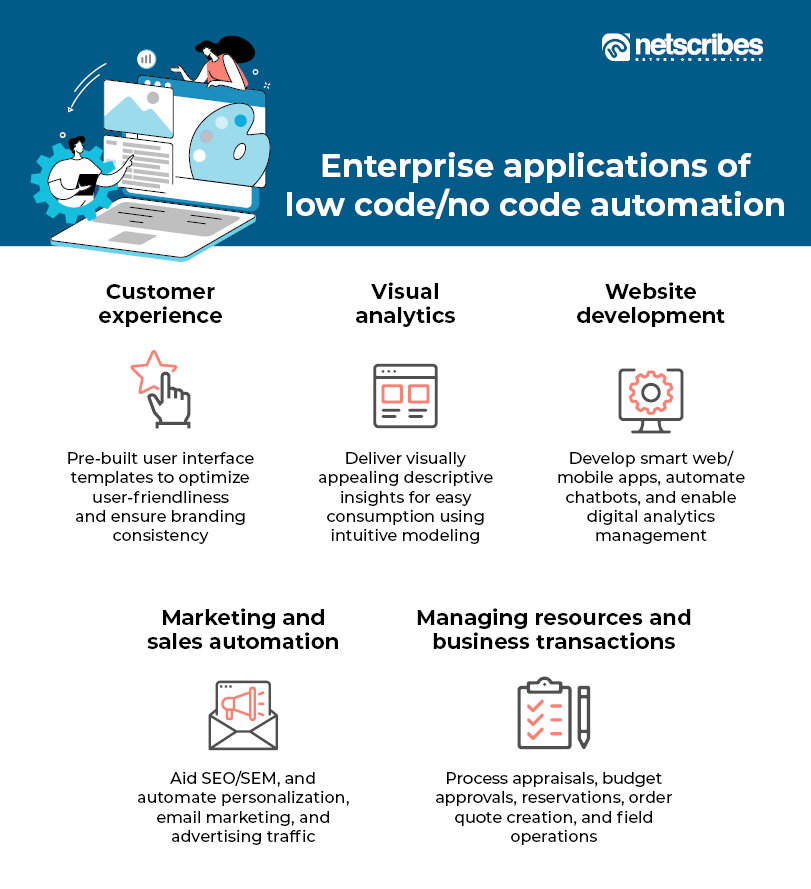Visual Development Environment:
Drag-and-Drop Interfaces: Low-code platforms provide visual tools for designing applications. Drag-and-drop elements enable developers to rapidly build applications without having to write extensive code.
Templates and components that are pre-built A lot of low-code platforms have pre-built components and templates that allow developers to quickly prototype and develop applications.
Reduced Coding Requirements for Coding:
Automated Code Generating: The low-code platform automatically generates the code underneath based upon the visual models that developers design. This means that there is less manual coding.
Reusable Components: Developers can reuse components across multiple projects, minimizing the time spent on writing and testing code.
Collaboration is made easier:
Low-code development platforms are typically equipped with tools like deployment control, version control and testing. This enables seamless collaboration across teams.
Development by citizens: Using intuitive interfaces and reducing bottlenecks often caused by the lack of developers, business users and non-developers are able to help in the development of applications.
Rapid Iteration, Prototyping:
Rapid prototyping: Designers can quickly design prototypes in order to gather feedback and validate concepts, which leads to faster cycles of iteration.
Easy Modifications. The visual interface low-code development provides allows users to easily update and change applications. This speeds up the process of enhancing and improving applications in response to the feedback of users.
Pre-built Integrations:
API Integrations: Platforms that are low-code often come with pre-built connectors for popular services and APIs, reducing the time required to connect external systems.
Data Integration: The built-in tools simplify the process of connecting databases with other sources, accelerating development.
The deployment of scaling:
One-Click deployment: Many platforms that make use of low-code have a one-click option for deploying applications, which can reduce time and effort.
Cloud-based solutions: Cloud low-code platforms are capable of handling the management of infrastructure and scaling. Developers can concentrate on the functionality and logic of the application rather than deployment logistic.
The overall speed of low-code app development lies in its ability to simplify and automate a number of aspects of the development. This allows for faster delivery of applications and faster adaption to changes in requirements. Follow the best Low-code Platform for application development info for website recommendations including push notifications, no code platforms, mobile app development platforms, application modernisation, push notifications, rapid application design, jdbc server, develop mobile application, multiplatform mobile app development, app modernisation and more.

Advantages Of Low Code Application Development For Governance And Security
Low-code applications offer a number of benefits in terms of security and governance, both of which are essential for ensuring that applications are compliant, secure, and well-managed throughout their entire life cycle. Below are the advantages of developing applications using low-code:
Unified Management console: A low-code platform typically provides a central dashboard for administrators to monitor and manage all apps and ensure that the governance is consistent across the entire organization.
Role-Based Access Control RBAC : These platforms typically include access controls that are based on roles. They allow administrators define and enforce policies. This ensures that only those with authorization can modify or access specific parts of the application.
Compliance and Regulatory Adherence
Built-In Compliance Features: Many low-code platforms are built to be compliant with industry norms and regulations (e.g., GDPR, HIPAA). They have frameworks and tools that help to ensure the applications are compliant with these standards.
Audit Trails and Logging Comprehensive logging, audit trails and logs are usually integrated into businesses that allow them to keep track of changes and track access. They also help to ensure compliance of internal and outside regulations.
Improved Security Measures:
Data Encryption Low-code platforms often include built-in encryption of data during transport and at rest, protecting sensitive data.
Security Certificates: A lot of low code providers have security certificate (e.g. ISO 27001 and SOC 2) which demonstrate that they are adhering to strict security guidelines. They provide an additional degree of security to customers.
Automated security updates:
Regularly scheduled updates and patches: Low-code platforms typically handle security updates and patches automatically, making sure that applications are secure from most recent threats, without the need for developer intervention manually.
Security Monitoring - Continuous monitoring of security is usually comprised. It provides real-time insight and alerts about potential security threats.
Data Governance
Data Access Policies: These software tools allow organisations to define as well as enforce and monitor data policies. This will ensure that the data is only accessible to authorized users and are used in a proper manner.
Data Masking Anonymization Data Masking Tools: Built-in data masking tools and features for anonymization help safeguard sensitive data, particularly during the development and testing phases.
Consistent Management of the lifecycle of an application
Pipelines for development and deployment Low code platforms have integrated development and deployment pipelines that include security checks. These ensure that security is maintained through the entire application lifecycle.
Version Control: An integrated version control system helps to manage changes, allowing any changes that are made to an application to be monitored. If required the changes can be reversed and the integrity of the application ensured.
User Authentication:
Single Sign-On - Support for single sign-on (SSO) as well as other advanced authentication mechanisms simplify management and enhances security.
Multi-Factor Authentication (MFA): Many platforms provide built-in support to multi-factor authentication, adding an extra layer of security to access applications.
Policy Enforcement and Compliance monitoring:
Low-code platforms have policies that are predefined to aid organizations in implementing security and governance policies as well as governance policies.
Tools for Monitoring Compliance: These instruments provide continuous monitoring, reporting and analysis of compliance status. It's easier to spot potential issues and take proactive action.
Integration into Existing Security Infrastructure:
Seamless Integration: Low-code platforms are designed to integrate seamlessly with existing security infrastructure and tools, such as identity management tools and SIEMs (Security Information and Event Management Solutions), and firewalls.
API Security API Security Features: Built-in API security functions make sure that integrations with external systems are secure, protecting data and maintaining application integrity.
Best Practices and Training:
Guided Best Practices: A number of platforms offer guidelines and best practices for developing secure applications, helping non-developers adhere to security standards.
Certain lowcode companies offer resources and security training for users to learn how they can build and maintain secure applications.
Overall, the governance and security benefits ensure that applications will be developed and maintained in a secure manner while remaining in compliance with the regulations, and under control. These platforms have the frameworks, tools, and regulatory compliance necessary to protect sensitive customer data as well as enforce policies and keep regulatory compliance in check as well as simplifying the administration and supervision of the development process. Follow the recommended her response about Enterprise application development with Low-code Platform for website examples including rapid action development, app modernisation, mobile app development platforms, application modernisation, build with docker, multiplatform mobile app development, develop cross platform mobile app, low code development platforms, push notifications android, rapid action development and more.

The Advantages Of Low-Code Development For Application Development In Terms Of Restrictions And The Possibility Of Customization
Low-code is an unbiased method that allows for substantial customization and overcomes limitations. Here are a few principal benefits: Handling limitations:
Resolving Complexity:
Low-code platforms facilitate development by providing pre-built templates and other components. This allows rapid deployment and the development of more complex applications.
Guided Workflows A lot of platforms provide workflows and wizards that help developers through complex processes. This helps to reduce the chance of errors, while ensuring consistency.
Scalability Solutions
Scalability is a part of the Low-code platforms typically include features that enable the development of scalable architecture. Applications are able to handle higher loads with minimal changes.
Performance Monitoring: Tools for monitoring and optimizing performance are built into the application to make sure it's efficient regardless of the size.
Security and compliance:
Integrated Security Features : Low codes platforms have security features that are built in, such as encryption and access control based on role. They also perform automated checks of compliance to address security concerns.
Platforms frequently update their security and compliance measures to ensure that applications are safe from new threats.
Features of Customization:
Extensibility:
Custom Code Integration : Low-code platforms often allow the integration of custom codes (e.g. JavaScript, Python) which enables developers to enhance the capabilities beyond what is available in the standard features.
Custom Modules and plugins: Developers have the option of creating custom modules or plugins to customize specific functionality to meet the specific requirements of a particular business.
APIs Integration:
API Support: Full API support allows seamless integration of other systems and services. This allows for the ability to customize and connect.
Third-Party Services: Low-code platforms often have pre-built connectors to well-known third-party services, which makes it easier to connect and modify applications.
Flexible Design for UI/UX:
Customizable interfaces: Users can customize and design their own user interfaces, which will provide users with a customized experience.
Responsive Design The built-in capabilities of responsive design guarantee that apps can be customized for different devices and screen sizes.
Making Business Logic more flexible is simple:
Visual Workflow Designers: These graphic tools can be used to customize and create workflows, as well as business logic, allowing developers to create complex tailored processes.
Conditional Logic and Scripting: Platforms allow the use of conditional logic, and scripting that is custom-made to handle specific business rules.
Data Management
Custom Data Models: Developers are able to define custom data models to fit specific needs of the application to ensure that data processing is custom-made to meet the needs of business.
Advanced Data Processor: The combination of advanced data processing tools and capabilities allows the customisation of the method by which data is processed and analysed in the application.
How to balance customisation with limits:
Frameworks, Standards and Standards:
Low-code platforms promote the use of industry-standards and best practices, which result in top-quality software that is flexible and secure.
Governance Frameworks. Built-in frameworks of governance make sure that any modifications do not compromise security, compliance or the integrity of the application.
Iterative Development and Feedback
Rapid prototyping: Developers are able to quickly test their customizations and prototypes based on the feedback of users, improving the application in line with their preferences.
Low-code platforms are designed to allow for continuous enhancement. This permits customizations and upgrades as the business needs evolve.
User Empowerment
Giving Citizen Developers the tools they need: Low-code platforms increase the number of developers who are capable of improving and customizing applications by permitting them to create custom intuitive user interfaces.
Training and Support: A lot of platforms provide comprehensive training and support to assist users with successful modifications that do not compromise the stability of the application, or its performance.
In general, low-code development gives a strong system for dealing with limitations, while providing ample opportunities for customization. This allows businesses are able to create and maintain apps that are both functional and customized to meet their particular requirements, while keeping high standards of quality, security and scaling.
